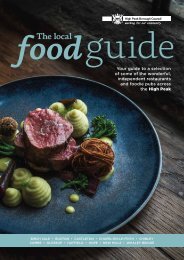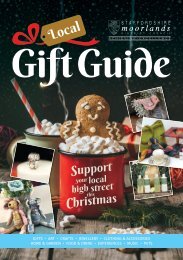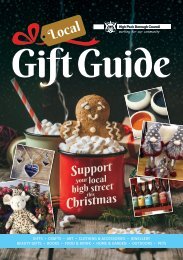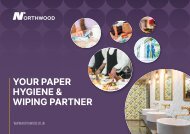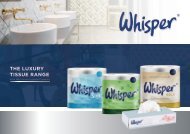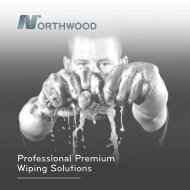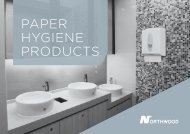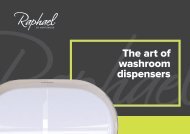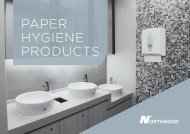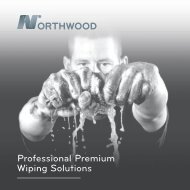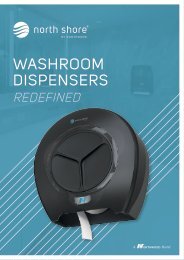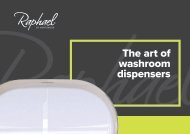Create successful ePaper yourself
Turn your PDF publications into a flip-book with our unique Google optimized e-Paper software.
<strong>Training</strong><br />
<strong>Manual</strong><br />
www.northwood.co.uk
The Making Process<br />
Making Paper Hygiene Products<br />
Toilet roll and hand towels can be made from either pure pulp or recycled paper.<br />
This means that they can be made from virgin paper, taken directly from trees, or<br />
reclaimed paper, which is in its secondary life.<br />
There is no discernible difference in quality between pure or recycled paper.<br />
Different types of trees have different properties and so toilet paper is usually made<br />
from a combination of hardwood and softwood trees. Softwood trees have long<br />
fibres that wrap around each other and gives paper strength. Hardwood trees have<br />
shorter fibres that gives softness.<br />
The process for making PURE PULP roll is as follows:<br />
Trees arrive at<br />
The batch of wood chips is<br />
1 the mill. 2 then mixed into a slurry<br />
and sent to a digester,<br />
where it is ‘cooked’. This<br />
process reduces the wood to<br />
cellulose fibres. These fibres are<br />
known as pulp.<br />
<strong>Training</strong> <strong>Manual</strong>
3<br />
The pulp then goes through a washing process that removes<br />
any other substances. The extracted chemicals can be reused<br />
for this process again.<br />
4<br />
The washed pulp goes<br />
through a whitening process<br />
to ensure that paper does not<br />
yellow over time.<br />
5<br />
The pulp is then mixed<br />
with water (99.9% water<br />
and 0.1% fibre). It is<br />
sprayed between moving mesh<br />
screens, allowing the water to<br />
drain and producing sheets of<br />
matted fibres.<br />
www.northwood.co.uk
6<br />
These sheets are then<br />
transferred to a dryer,<br />
where the moisture<br />
content is reduced to<br />
about 5%. The paper is then<br />
scraped off the dryer. This<br />
process gives the tissue its<br />
required softness and<br />
flexability but lowers its<br />
strength. The paper<br />
is then wound onto<br />
jumbo reels that<br />
can weigh as<br />
much as 5 tons.<br />
7<br />
Paper is then sent to<br />
converting machines,<br />
that unwind and cut<br />
the paper, then rewind<br />
onto cardboard cores to<br />
form the rolls that we are<br />
all familiar with.<br />
For RECYCLED PAPER, only the first stage differs, whereby<br />
reclaimed paper goes through a process to remove foreign<br />
bodies, such as staples and plastics. It is then mixed with hot<br />
water and detergents to clean and remove inks. The process<br />
from then on matches the pure pulp product in being sprayed<br />
onto mesh screens, dried and wound onto jumbo rolls.<br />
Did you know?<br />
For every ton of reclaimed paper, 3.3 cubic yards is saved<br />
from landfill (that’s the equivalent of 3 washing machines!).<br />
Northwood recycles over 75,000 tons of material every<br />
year, the equivalent of 225,000 washing machines<br />
taken from landfill and put back into the supply chain!<br />
<strong>Training</strong> <strong>Manual</strong>
Jargon Buster<br />
Before we get started, let’s get into some of the jargon that is typically used<br />
with paper products:<br />
Ply – the quantity of sheets used<br />
to give the product more weight and<br />
bulk. 1 ply is considered entry level<br />
product, with 2 and 3 ply being<br />
more premium.<br />
GSM – grams per square metre.<br />
This refers to the ‘weight’ of paper<br />
used. Generally speaking, the higher<br />
the GSM the better quality of<br />
product.<br />
Embossed – there are different<br />
types of emboss, but papers are<br />
embossed to give them added<br />
strength and absorbency, through<br />
their increased surface area.<br />
Laminated – this is the most<br />
premium form of attaching the<br />
sheet plies together.<br />
Eco Label – this is<br />
an accreditation given<br />
by the European Union<br />
to products that hit the<br />
most stringent of ‘green’ credentials.<br />
A key selling feature to customers<br />
who are environmentally conscious.<br />
Many Northwood products carry<br />
this accreditation.<br />
Mother/Parent Reel - A Large<br />
reel from a mill<br />
Cores – the cardboard inner to a roll that<br />
the paper is wound around.<br />
Core Size – The diameter of the core<br />
can vary within products.<br />
Pulp – the fibrous material used to make<br />
paper product.<br />
Perforations – the small ‘rips’ in each<br />
sheet making it easy to tear.<br />
Systems – specifically engineered<br />
dispensers for a range of products.<br />
Base Sheet – the term used to refer to<br />
the paper. Base sheet encompasses all<br />
quality features.<br />
Non Woven – non paper products for<br />
wiping tasks that have increased strength<br />
and absorbency, generally used for<br />
specialist wiping rather than general spills.<br />
Often multi-use.<br />
CHSA – Cleaning and<br />
Hygiene Suppliers Association<br />
Soft Tissue Standard. A scheme<br />
that gurantees that all products<br />
are fully labelled with lengths,<br />
widths and sheet counts etc, and a<br />
guarantee that the product in the box<br />
meets the specification on the label. All<br />
Northwood products proudly meet<br />
this standard.<br />
www.northwood.co.uk
Washroom<br />
Toilet Roll<br />
Conventional<br />
Conventional Toilet Rolls are<br />
the domestic style format of<br />
roll. Typically, these are<br />
available in either 200 or 320<br />
sheet counts.<br />
Coreless<br />
Some toilet rolls are<br />
coreless. Toilet roll cores<br />
are recyclable but this<br />
format reduces the<br />
need for one.<br />
Jumbo<br />
There are many forms of jumbo toilet roll (jumbo, midi<br />
jumbo, mini jumbo), but as the name suggests, these are<br />
just large (in some cases very large!) toilet rolls.<br />
Rolls tend to come in the<br />
following lengths:<br />
150m & 200m – Mini Jumbo<br />
250m – Midi Jumbo<br />
300 & 400m – Jumbo<br />
These are typically available in 2<br />
different core sizes: 76mm and<br />
62mm, but generally have the same<br />
width of sheet.<br />
<strong>Training</strong> <strong>Manual</strong>
Did you know?<br />
The average person<br />
spends 3 years of<br />
their life on the<br />
toilet, visiting 2,500<br />
times per year.<br />
We use an<br />
average of 57<br />
sheets of<br />
paper a day, the<br />
equivalent of<br />
around 3 metres!<br />
The average toilet<br />
is flushed 8<br />
times a day!<br />
The cleanest public<br />
toilet is typically<br />
the first one, as<br />
it is the least<br />
frequently used.<br />
Brits lead the way in<br />
toilet paper use with<br />
the highest<br />
consumption per<br />
person, 25 times the<br />
amount used by the<br />
people of Ukraine.<br />
www.northwood.co.uk
Washroom<br />
Hand Towels<br />
Roll Towel (Hand Towels)<br />
Roll Towels are available in a wide<br />
variety of lengths. Available as<br />
continuous rolls and the dispenser<br />
cuts to a pre-determined length.<br />
They are generally available in blue<br />
and white colours.<br />
Did you know?<br />
In a recent survey at a Service Station, 99% of people<br />
interviewed said they had washed their hands after visiting<br />
the toilet. Washroom data showed otherwise, with only<br />
32% of men and 64% of women actually had!<br />
Hand washing was only linked to the spread<br />
of germs in 1847! At the time, nobody<br />
believed Hungarian Ignaz P. Semmelweiss, and<br />
so committed him to an insane asylum.<br />
<strong>Training</strong> <strong>Manual</strong>
Washroom<br />
Hand Towels<br />
Folded Hand Towel<br />
There are three different formats to the<br />
folded paper towel (C Fold / Z Fold / V<br />
Fold), but they all just refer to the way<br />
that they have been folded. Generally,<br />
sheet sizes are similar and tend to be<br />
available in white, blue and green<br />
colourways. Folded hand towels are<br />
sold in packaged sleeves.<br />
There are a variety of different<br />
names for folded towels, but<br />
many of them are just the same<br />
thing. Here is what they mean:<br />
V Fold = Interfold / Single Fold<br />
Z Fold = S Fold / M Fold<br />
C Fold = Only known by this name<br />
Z Fold and V Fold towels have been<br />
designed to dispense one at a time, so<br />
when removing one from a dispenser,<br />
the next is left slightly exposed making<br />
it easy to remove. They are designed to<br />
work with systems, whereas C Fold are<br />
typically seen as generic commodity<br />
items.<br />
Paper towels tend not to be flushable,<br />
as their tougher qualities mean that it is<br />
more difficult to breakdown in water.<br />
However, Flight Towels are available<br />
from Northwood under the Optimum<br />
brand, which do breakdown when<br />
agitated in water. This is beneficial<br />
where disposing of waste is not easy i.e.<br />
aircraft – hence the name!<br />
Z Fold C Fold V Fold<br />
www.northwood.co.uk
Washroom<br />
Roll Towels and Folded Towels are the<br />
most environmentally friendly and<br />
hygienic method of hand drying.<br />
Re-usable hand towels harbour and spread<br />
germs. The rewashing process means they are<br />
energy inefficient and release more pollutants<br />
into the water supply.<br />
Electronic hand dryers are also susceptible to<br />
being unhygienic, with the blow of the dryer<br />
spreading germs across the washroom.<br />
They are also energy inefficient<br />
through their production of heat<br />
and noise.<br />
Did you know?<br />
In a recent study of a Detroit school, children who washed their hands had<br />
24% fewer sick days due to respiratory illness and 51% fewer sick<br />
days due to upset stomach. Hand washing reduces absences and<br />
improves productivity!<br />
<strong>Training</strong> <strong>Manual</strong>
Washroom<br />
Systems<br />
Dispenser systems are used to<br />
control usage and cost of paper<br />
products, and to give an upmarket<br />
finish to any washroom. Through<br />
their engineering, dispensers can be<br />
designed to hold multiple rolls, only<br />
exposing a new one once the first<br />
has been fully used (reducing waste).<br />
Multiple roll options also reduce<br />
janitorial time, with less frequent<br />
refills needed.<br />
Often these are the best way to<br />
manage washroom hygiene, with<br />
easy to wipe surfaces, no touch<br />
dispensing and contained / clean<br />
dispensing, meaning paper is free<br />
from dirt and grime.<br />
www.northwood.co.uk
Leonardo offers a full<br />
complement of washroom<br />
dispensers to give an upmarket<br />
finish to any location, suitable<br />
for use at both front and back<br />
of house functions.<br />
Key features of systems include:<br />
• Consumption & waste reduction<br />
• Janitorial and maintenance reduction<br />
• Suitable for use in high and low<br />
footfall areas<br />
• Suitable for use in front and back<br />
of house<br />
• Hygienic<br />
• Durable and long lasting<br />
• Lockable systems prevent<br />
theft of paper<br />
Did you know?<br />
50% of Brits admitted<br />
to taking hotel property<br />
including toiletries<br />
and tissue<br />
<strong>Training</strong> <strong>Manual</strong>
Hygiene<br />
Hygiene Roll<br />
Hygiene Rolls, also known as Couch/Bed<br />
Rolls or Medical Rolls, are mainly used in the<br />
hair and beauty and medical sectors.<br />
Industry standard widths<br />
are 250mm (10”) or<br />
500mm (20”), and are<br />
typically available in 40m<br />
and 50m lengths. Hygiene<br />
rolls are available in blue<br />
and white, with<br />
Northwood also offering<br />
in pink. All rolls are<br />
individually wrapped for<br />
hygiene purposes.<br />
Janitorial<br />
Centrefeed<br />
Centrefeed rolls have a removable core,<br />
meaning that they can be pulled from<br />
the centre, making it more hygienic as<br />
only the outside layer is exposed. They<br />
can be used for a variety of wiping<br />
tasks, generally used for lighter spillages<br />
and hand drying. Emboss and additional<br />
plies make these products suitable for<br />
more heavy duty tasks.<br />
Typically available in blue and white<br />
colours. Blue roll is generally used<br />
where hygiene is essential in food<br />
environments.<br />
Rolls are available in a multitude of<br />
lengths and widths, and can be used in<br />
dispensers for more controlled and<br />
hygienic consumption.<br />
www.northwood.co.uk
Wiping<br />
Non Woven<br />
For more premium wiping solutions, non woven rather than paper should be used.<br />
They give added absorbency and strength, and the option for multi-use (as opposed<br />
to paper, which is single use).<br />
These are generally considered more specialist wipes, and have more sector specific<br />
uses such as Northwood’s Optimum Pro Wipers Resource Rag, perfect for lndustrial<br />
and Automotive use due to its high absorbtion, low linting, chemical free and<br />
chemical compatible qualities.<br />
• Low lint – essential for polishing,<br />
and when a total clean surface is<br />
required.<br />
• Heat and Solvent resistant<br />
– this makes wipes excellent for<br />
janitorial cleaning, amongst other<br />
uses, for its compatibility with<br />
cleaning products.<br />
All Northwood non woven wipes<br />
are formaldehyde free.<br />
Non woven are generally available<br />
in folded formats, centrefeed,<br />
standard roll or loose rags.<br />
• Colour coding – when re-useable<br />
are beneficial but cross contamination<br />
needs to be prevented. Optimum Pro<br />
Wiper’s Smart Wipe is available in 4<br />
colourways.<br />
<strong>Training</strong> <strong>Manual</strong>
Accreditations<br />
Ecolabel : Licence Number: UK/04/005 / UK/04/002<br />
Awarded to all Northwood recycled products manufactured<br />
from recycled parent reels made at the Northwood mills<br />
(Lancaster & Disley) - this covers the entirety of the Essentials<br />
range excluding hand towels. Many Leonardo recycled tissue<br />
products also carry the Ecolabel accreditation.<br />
CHSA<br />
The Cleaning and Hygiene Suppliers Association soft tissue<br />
standard. A scheme that guarantees all products are fully<br />
labelled with lengths, widths and sheet counts etc, and a<br />
guarantee that the product in the box meets the specification<br />
on the label.<br />
BRC Certification<br />
A Global Standards Consumer Products certification covering<br />
products that are sold from our Telford site.<br />
The standard sets out the requirements for the production and<br />
supply of the safe and legal consumer products of consistent<br />
quality. The products may be retailer-branded (private label),<br />
branded or unbranded for use by other organisations.<br />
ISO 9001<br />
FM 558673<br />
The International Standard is based on the quality management<br />
principles which are; customer focus, leadership, engagement of<br />
people, process approach, improvement, evidence based<br />
decision making and relationship management. The above is all<br />
to enhance customer satisfaction by meeting customer<br />
requirements. This standard covers all three converting sites<br />
(Telford, Penygroes & Meltham) and is awarded by Royal Charter.<br />
www.northwood.co.uk
Northwood Hygiene Products | Northwood House | Stafford Park 10 | Telford | Shropshire | TF3 3AB | Tel: 01952 236930<br />
Email: customer.service@northwood.co.uk | Web: www.northwood.co.uk





